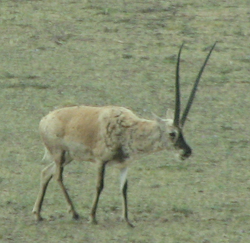Pantholops hodgsonii: Difference between revisions
m (Movebot moved page Talk:Pantholops hodgsonii to Pantholops hodgsonii without leaving a redirect: BP:MOVE) |
No edit summary |
||
| Line 3: | Line 3: | ||
== References == | == References == | ||
{{ | {{Reflist}} | ||
== Other websites == | == Other websites == | ||
* [https://www.youtube.com/watch?v=eI1LRx-YyEM Chinese Scientists Witness Tibetan Antelopes' Life or Death Migration; YouTube] | * [https://www.youtube.com/watch?v=eI1LRx-YyEM Chinese Scientists Witness Tibetan Antelopes' Life or Death Migration; YouTube] | ||
{{Biology-stub}} | |||
[[Category:Caprids]] | [[Category:Caprids]] | ||
[[Category:Mammals of Asia]] | [[Category:Mammals of Asia]] | ||
[[Category:Symbols of Tibet (China)]] | |||
Latest revision as of 00:37, 12 August 2022
Tibetan antelope, also known as Chiru is a medium sized antelope most closely related to wild goats and sheep of the subfamily Caprinae.[1] Tibetan antelope are native to northwest India and Tibet.[2] They live on the treeless Steppe above 5,000 metres (16,000 ft).[2] They are an endangered species.[3] They are a target for hunters for their fine underfur called chiru.[4] It is used to make luxury shawls.[4] It takes about four animals to make a single shawl.[4] In order to collect the chiru, the animals must be killed.[4] Because of this the Chiru are close to extinction.[4]
References[edit]
- ↑ "Tibetan Antelope". Tibet Nature Environmental Conservation Network. January 21, 2014. Retrieved January 23, 2017.
- ↑ 2.0 2.1 "Tibetan Antelope". Endangered Species Handbook. Animal Welfare Institute. Retrieved January 22, 2017.
- ↑ "Pantholops hodgsonii". IUCN Red List of Threatened Species. International Union for Conservation of Nature and Natural Resources. Retrieved January 22, 2017.
- ↑ 4.0 4.1 4.2 4.3 4.4 "Tibetan antelope". World Wide Fund For Nature. Retrieved January 22, 2017.
